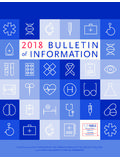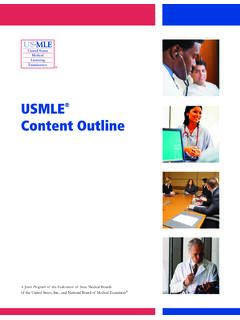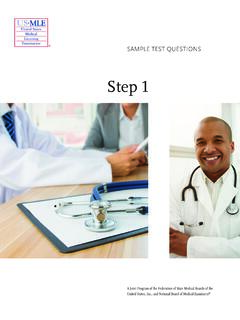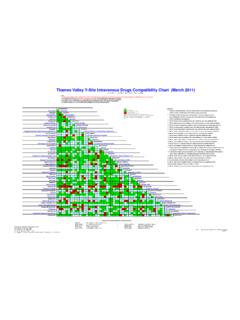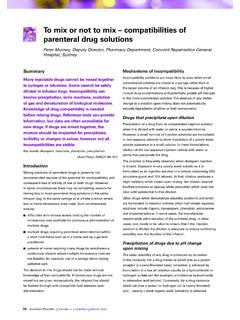Transcription of Step 3 Sample Questions November 2020 - USMLE
1 step 3 Sample TEST QUESTIONSA Joint Program of the Federation of State Medical Boards of the United States, Inc., and the National Board of Medical Examiners Copyright 2020 by the Federation of State Medical Boards of the United States, Inc. (FSMB), and National Board of Medical Examiners (NBME ). All rights reserved. Printed in the United States of America. The United States Medical Licensing Examination ( USMLE ) is a joint program of the FSMB and NBME. This booklet was updated November 2020. USMLE step 3 Multiple Choice Test Question Formats.
2 2 Introduction to USMLE step 3 Sample Test 6 USMLE step 3 Normal Laboratory Values .. 7 Answer Form for USMLE step 3 Sample Questions .. 10 USMLE step 3 Sample Test Questions .. 11 Answer Key for USMLE step 3 Sample Questions .. 79 CONTENTS 2 The following are strategies for answering one-best-answer Questions (eg, Single Items, Multiple Item Sets, and Sequential Item Sets): Read each patient vignette and question carefully. It is important to understand what is being asked. Try to generate an answer and then look for it in the option list. Alternatively, read each option carefully, eliminating those that are clearly incorrect.
3 Of the remaining options, select the one that is most correct. If unsure about an answer, it is better to guess since unanswered Questions are automatically counted as wrong answers. Patient Scenario Formats Patient scenarios for any Single Item or Sequential Item Set may be provided in either Vignette (paragraph) format, or in Chart/Tabular format. Questions written in Chart/Tabular format will contain relevant patient information in list form, organized in clearly marked sections for ease of review. Familiar medical abbreviations may be used within Chart/Tabular format Questions .
4 Single-Item Questions A single patient-centered scenario is associated with one question followed by four or more response options. The response options for all Questions are lettered (ie, A, B, C, D, E). You are required to select the best answer to the question. Other options may be partially correct, but there is only ONE BEST answer. This is the traditional, most frequently used multiple-choice question format on the examination. Example Question 1 1. A 30-year-old man comes to the emergency department because of an acute episode of renal colic. Medical history is remarkable for episodes of painful urination and passing of what he calls "gravel in my urine.
5 " Urinalysis demonstrates microscopic hematuria with some crystalluria and no casts. Supine x-ray of the abdomen shows no abnormalities. A 4-mm renal calculus is detected in the distal right ureter on ultrasonography. There is no evidence of dilation of the collecting system. The patient's pain is responsive to narcotic medication. In addition to administering intravenous fluids, which of the following is the most appropriate next step ? A. Acidification of urine by drinking cranberry juice B. Cystoscopic removal of the calculus C. Cystoscopic ureteral lavage D. Shock wave lithotripsy E.
6 Straining of the urine (Answer: E) USMLE step 3 MULTIPLE-CHOICE TEST QUESTION FORMATS 3 Multiple Item Sets A single patient-centered scenario may be associated with two or three consecutive Questions about the information presented. Each question within these sets is associated with the patient scenario and is independent of the other question(s) in the set. The Questions within this type of format are designed to be answered in any order. You are required to select the ONE BEST answer to each question. Example Questions 2 to 3 A 52-year-old man returns to the office for reevaluation of an ulcer on his right great toe.
7 The patient has a 15-year history of diabetes mellitus and takes glipizide and rosiglitazone. He first noticed the ulcer 2 months ago. One month ago, a 14-day course of oral amoxicillin-clavulanate therapy was prescribed. He has smoked one pack of cigarettes daily for the past 37 years. He is 178 cm (5 ft 10 in) tall and weighs 102 kg (225 lb); BMI is 32 kg/m2. Today, vital signs are temperature C ( F), pulse 96/min, respirations 12/min, and blood pressure 130/85 mm Hg. Physical examination of the right great toe discloses a nontender ulcer with a depth of cm, a moist base, yellow exudate, and surrounding erythema to the level of the malleoli.
8 Vibration sense and sensation to monofilament examination are absent. Pulses are diminished in both feet. Capillary refill time is 2 seconds in the right great toe. Urinalysis discloses 3+ protein. 2. Which of the following historical factors or physical examination findings is most strongly associated with development of this patient's foot ulcer? A. Diminished pedal pulses B. Neurologic findings C. The patient's weight D. Proteinuria E. Tobacco use (Answer: B) 3. Which of the following is the most appropriate action at this time? A. Begin aggressive debridement in the office B.
9 Begin intravenous antibiotic therapy C. Refer the patient for transmetatarsal amputation D. Schedule the patient for a third-degree skin graft E. Switch the amoxicillin-clavulanate to oral ciprofloxacin (Answer: B) 4 Sequential Item Sets A single patient-centered scenario may be associated with two or three consecutive Questions about the information presented. Each question is associated with the initial patient scenario but is testing a different point. You are required to select the ONE BEST answer to each question. Questions are designed to be answered in sequential order.
10 You must click "Proceed to Next Item" to view the next question in the set; once you click on this button, the next question will be displayed, and you will not be able to add or change an answer to the previous question. Example Questions 4 to 5 A 2-year-old girl is brought to the office by her mother for evaluation of fever. You have been the girl's physician since birth. While in the office, the girl stiffens and then has bilateral, symmetrical shaking of her upper and lower extremities; she becomes mildly cyanotic. The episode lasts for approximately 45 seconds, after which she becomes relaxed and appears to fall asleep.


